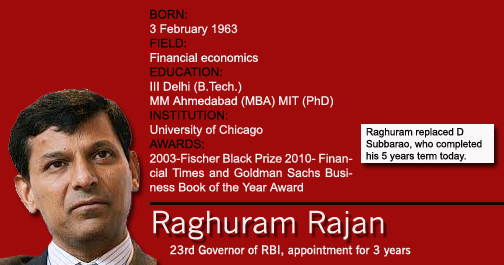
In an attempt to check the decline in value of Indian currency, Indian government Wednesday appointed Raghuram Rajan, an economist and former chief economist with International Monetary Fund (IMF), as Governor of country’s central Bank — Reserve Bank of India (RBI).
New Delhi, Sept 4/Nationalturk – Raghuram Rajan, an Indian economist and former chief economist with International Monetary Fund (IMF), Wednesday took over as Governor of India’s central Bank — Reserve Bank of India (RBI).
His posting as head of India’s central bank comes at a time when Indian economy is facing severe crisis and Indian currency Rupee has been witnessing decline in its value.
Rajan will be head of RBI for three-years. After expiry of his three-year term, Indian government can extend his tenure if it is satisfied with his performance and work.
“We have enough ideas. It is not just the currency, it is financial inclusion, it is growth. I think there is a lot to do. There are challenges in the economy. These things are not going to be overcome overnight. There is no magic wand. But there are undoubtedly solutions to many of the problems that the RBI can tackle and the job is to go ahead and do it, 50-year-old Rajan had told reporters yesterday.
He said they will do it one step at a time. “We will make sure that it progresses everyday”.
Rajan was appointed as Chief Economic Advisor in Indian Finance Ministry in August last year.
Rajan is 23rd Governor of RBI
According to economic experts, Rajan, who is 23rd Governor of RBI, was hailed for predicting 2008 global financial crisis. “In 2005, he delivered a lecture critical of the financial sector, arguing that a financial disaster might be looming”.
They said impacted by high Current Account Deficit (CAD), Indian rupee declined sharply touching an all-time low of 68.80 to a dollar last week. The rupee has plunged nearly 20 per cent since May as Asia’s third-largest economy confronts its worst crisis since 1990-1991. Indian government’s efforts to stabilise the rupee have done little to halt its steep slide.
“Indian government and RBI will have a difficult task of bringing CAD down to USD 70 billion in the current fiscal, from USD 88.2 billion last year. The rising cost of crude oil import will continue to put pressure on the CAD,” financial experts said.
Economic analysts expect Rajan to improve the central bank’s communication with markets, which could help in restoring confidence among investors. “The outgoing RBI governor Subbarao was criticised for failing to communicate the central bank’s exchange rate policy effectively”.
Meanwhile, the appointment of Rajan as Governor of RBI had a good impact on Indian and global business market.
The Indian rupee resumed lower at 68.10 per dollar against the last closing level of 67.63 at the Interbank foreign exchange (Forex) market and dropped further to a low of 68.62.
However, the Indian currency recovered afterwards to 66.93 in view of surge in the equity market.
The analysts said this is a good sign and they are hopeful that value of Indian rupee can recover if Rajan takes some positive steps aimed at boosting confidence of foreign investors.
Goldman Sachs predicts further fall in Indian currency
The Goldman Sachs has predicted that Indian rupee was likely to full further and may reach Rs. 72 per dollar in next six months.
“In India, we have cut our full-year GDP growth forecast to 4% from 6%,” Goldman Sachs said in a research note.
It predicted that Indian rupee may fall to 72 per dollar in six months’ time.
Goldman Sachs said there was a risk of “near-term overshooting of our targets if economic and financing conditions worsen, and especially if there are pressures on the banking and corporate sectors due to weakness in growth”.
It said in the near term, it sees risks as the economy is likely to need an adjustment in the current account and fiscal balances. “It may require below-potential growth for several more quarters to reduce inflation, before we can see an economic recovery”.
Write your comments and thoughts below
Faiz Ahmad / NationalTurk India News
[adrotate banner=”41″]
